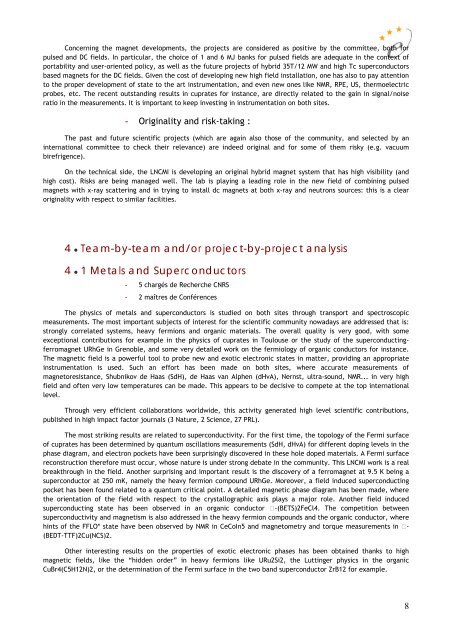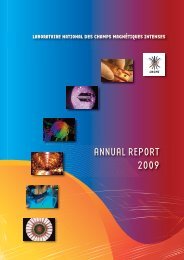Laboratoire National des Champs Magnétiques Pulsés CNRS – INSA
Laboratoire National des Champs Magnétiques Pulsés CNRS – INSA
Laboratoire National des Champs Magnétiques Pulsés CNRS – INSA
You also want an ePaper? Increase the reach of your titles
YUMPU automatically turns print PDFs into web optimized ePapers that Google loves.
Concerning the magnet developments, the projects are considered as positive by the committee, both for<br />
pulsed and DC fields. In particular, the choice of 1 and 6 MJ banks for pulsed fields are adequate in the context of<br />
portability and user-oriented policy, as well as the future projects of hybrid 35T/12 MW and high Tc superconductors<br />
based magnets for the DC fields. Given the cost of developing new high field installation, one has also to pay attention<br />
to the proper development of state to the art instrumentation, and even new ones like NMR, RPE, US, thermoelectric<br />
probes, etc. The recent outstanding results in cuprates for instance, are directly related to the gain in signal/noise<br />
ratio in the measurements. It is important to keep investing in instrumentation on both sites.<br />
- Originality and risk-taking :<br />
The past and future scientific projects (which are again also those of the community, and selected by an<br />
international committee to check their relevance) are indeed original and for some of them risky (e.g. vacuum<br />
birefrigence).<br />
On the technical side, the LNCMI is developing an original hybrid magnet system that has high visibility (and<br />
high cost). Risks are being managed well. The lab is playing a leading role in the new field of combining pulsed<br />
magnets with x-ray scattering and in trying to install dc magnets at both x-ray and neutrons sources: this is a clear<br />
originality with respect to similar facilities.<br />
4 � Team-by-team and/or project-by-project analysis<br />
4 � 1 Metals and Superconductors<br />
- 5 chargés de Recherche <strong>CNRS</strong><br />
- 2 maîtres de Conférences<br />
The physics of metals and superconductors is studied on both sites through transport and spectroscopic<br />
measurements. The most important subjects of interest for the scientific community nowadays are addressed that is:<br />
strongly correlated systems, heavy fermions and organic materials. The overall quality is very good, with some<br />
exceptional contributions for example in the physics of cuprates in Toulouse or the study of the superconductingferromagnet<br />
URhGe in Grenoble, and some very detailed work on the fermiology of organic conductors for instance.<br />
The magnetic field is a powerful tool to probe new and exotic electronic states in matter, providing an appropriate<br />
instrumentation is used. Such an effort has been made on both sites, where accurate measurements of<br />
magnetoresistance, Shubnikov de Haas (SdH), de Haas van Alphen (dHvA), Nernst, ultra-sound, NMR... in very high<br />
field and often very low temperatures can be made. This appears to be decisive to compete at the top international<br />
level.<br />
Through very efficient collaborations worldwide, this activity generated high level scientific contributions,<br />
published in high impact factor journals (3 Nature, 2 Science, 27 PRL).<br />
The most striking results are related to superconductivity. For the first time, the topology of the Fermi surface<br />
of cuprates has been determined by quantum oscillations measurements (SdH, dHvA) for different doping levels in the<br />
phase diagram, and electron pockets have been surprisingly discovered in these hole doped materials. A Fermi surface<br />
reconstruction therefore must occur, whose nature is under strong debate in the community. This LNCMI work is a real<br />
breakthrough in the field. Another surprising and important result is the discovery of a ferromagnet at 9.5 K being a<br />
superconductor at 250 mK, namely the heavy fermion compound URhGe. Moreover, a field induced superconducting<br />
pocket has been found related to a quantum critical point. A detailed magnetic phase diagram has been made, where<br />
the orientation of the field with respect to the crystallographic axis plays a major role. Another field induced<br />
superconducting state has been observed in an organic conductor -(BETS)2FeCl4. The competition between<br />
superconductivity and magnetism is also addressed in the heavy fermion compounds and the organic conductor, where<br />
hints of the FFLO* state have been observed by NMR in CeCoIn5 and magnetometry and torque measurements in -<br />
(BEDT-TTF)2Cu(NCS)2.<br />
Other interesting results on the properties of exotic electronic phases has been obtained thanks to high<br />
magnetic fields, like the “hidden order” in heavy fermions like URu2Si2, the Luttinger physics in the organic<br />
CuBr4(C5H12N)2, or the determination of the Fermi surface in the two band superconductor ZrB12 for example.<br />
8







